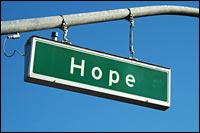
This isn’t a top ten list — I couldn’t find that many signs of hope! And yes, I realize that some items on the list are only holding actions. The exercise was a little depressing; I had to wade through a year’s worth of stories describing ecological devastation to come up with these.
Given all that, I would still say that 2006 was the best year the cause of environmentalism has seen in decades. I suspect that Grist, along with its readers and commenters, played a bigger part in that than most realize. May that trend continue and accelerate through 2007 and beyond. The list begins below the fold:
- Plans were recently announced to create two new protected areas in the war-torn Republic of Congo (3,800 square miles — it would take 4 hours to drive around its periphery at 60 MPH).
- Plans to create the world’s largest palm oil plantation along the border of Malaysia and Indonesia were scuttled as part of the Heart of Borneo Initiative (7,000 square miles — it would have taken 5.5 hours to drive around its periphery at 60 MPH).
- One third of the Great Bear Rainforest is now protected from logging (7,800 square miles — 5.8 hours to drive around its periphery at 60 MPH).
- Brazil has created the world’s largest contiguous block of protected rainforest (22,000 square miles — 10 hours to drive around its periphery at 60 MPH).
- The Arctic National Wildlife Refuge remains a refuge (30,000 square miles — 11.5 hours to drive around its periphery at 60 MPH).
- The creation of the world’s largest marine preserve (140,000 square miles — 25 hours to drive a boat around its periphery at 60 MPH).
- The 2001 Roadless Area Conservation Rule has been reinstated (440,000 miles of logging roads run through our national forests alone, representing 7,333 hours in a car at 60 MPH).
- The half-million mark in Prius sales was crossed this year. The fleet saves a quarter of a billion gallons of gas annually (that represents 100 million hours spent in cars moving at 60 MPH) without having to feed one drop of pesticide or fertilizer to the Gulf of Mexico dead zone or plow under one acre of conservation reserve or rainforest carbon sink. The first of many examples I hope to see of the power of the free market to satiate the needs and urges of billions and billions of upright walking primates in increasingly environmentally benign ways.
Genetic research suggests that our human lineage came close to extinction at one point in the past. It was a bottleneck we managed to squeeze through, and when we came out on the other side, the slope of the line representing our technology growth over time began to lean gently upwards. A technological explosion occurred, with new kinds of hunting instruments, sewing needles, farming, domestication of wild animals, and the discovery of metals.
That gently sloping line has become an exponential curve. Our population growth, the result of that technological growth, has fortunately not turned out to be exponential also. As a result of those two intersecting growth curves, humanity now finds itself in another bottleneck — this time with the rest of nature facing extinction at our hands. There is no going backward. If we fail to preserve our biodiversity while passing through this bottleneck, when we finally come out the other side we will be find ourselves entering a third bottleneck, struggling to survive in a biologically impoverished wasteland — a world we are not evolved to live in.
There will be no solution to that bottleneck, because extinction is permanent. It is our job as environmentalists to find ways to channel the profit motive toward solutions that will not consume what remains of our biodiversity and the carbon sinks it survives in.
“The race is now on between the technoscientific forces that are destroying the living environment and those that can be harnessed to save it.” — E. O. Wilson



